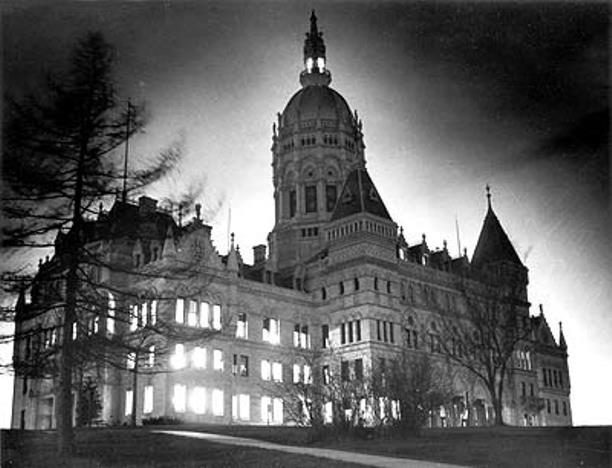Last Updated: March 11, 2025
The Connecticut State Capitol building first opened to the General Assembly in January 1879. As the seat of state government, the building houses the State Senate, the State House of Representatives, and the offices of the Governor, Lieutenant Governor, and Secretary of the State.
The Need for a New Capitol
Starting in the early 18th century, Connecticut had two capitals: Hartford and New Haven. The state legislature rotated between the two cities, but by the 1870s, the practice of having dual capitols was awkward and ineffective. In a public referendum in October 1873, the Hartford faction won by a narrow margin. Effective in 1875, Hartford became Connecticut’s sole state capital city.
Building a New Capitol in Hartford
When meeting in Hartford, the General Assembly previously gathered in the Old State House. That building, however, needed structural repairs and additional meeting space. When Hartford won the sole state capital title, both the state legislature and the city of Hartford contributed funds towards a new state capitol building. The site for the new state house, overlooking Bushnell Park, was formerly the location of Trinity College (then known as Washington College).
Cathedral architect Richard Mitchell Upjohn designed the Capitol. The building design is in the High Victorian Gothic style, but it contains a variety of other architectural influences as well. The contractor, James G. Batterson, also added his own revisions to the building plan. The building was completed in only six years, using marble and granite primarily from Connecticut and the surrounding New England states.
Representing Connecticut
As the State Capitol, the building represents the people and history of the entire state of Connecticut. In addition to the state government, the building includes historical artifacts and exhibits about Connecticut’s state history, such as the Hall of Flags. The exterior of the building includes an ornate façade and detailing, including numerous statues representing figures important to the state’s history. The most recent sculpture added was of Ella T. Grasso, Connecticut’s first female Governor.
From 1878 to 1938, the bronze “Genius of Connecticut” statue stood on top of the Capitol dome, symbolically a protector of Connecticut. After damage from a hurricane in 1938, the state removed the statue and the federal government eventually melted it down during WWII. Connecticut restored the plaster mold in the 1980s and recast a new bronze statue in the early 2000s. Until it can be re-installed on top of the Capitol, the (new) Genius rests at the base of the dome.
The Connecticut State Capitol was named a National Historical Landmark in 1971. From 1979 to 1989, the building underwent a complete restoration. Still in use today, the State Capitol continues to be a crucial site of lawmaking, state business, protest, advocacy, and more.
This article was partly adapted using content from the Imagining Connecticut exhibit that formerly hung in the Connecticut State Capitol and Legislative Office Building starting in 2000.
This article has been updated, learn more about content updating on ConnecticutHistory.org here.









